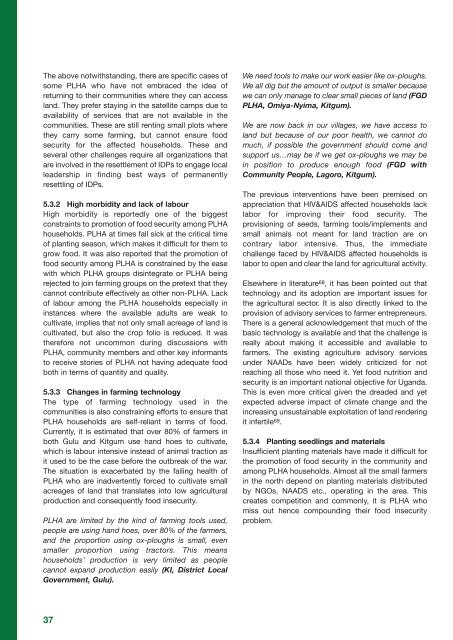Uganda Report 2012 FINAL PO:Layout 1 - ACORD
Uganda Report 2012 FINAL PO:Layout 1 - ACORD
Uganda Report 2012 FINAL PO:Layout 1 - ACORD
Create successful ePaper yourself
Turn your PDF publications into a flip-book with our unique Google optimized e-Paper software.
The above notwithstanding, there are specific cases of<br />
some PLHA who have not embraced the idea of<br />
returning to their communities where they can access<br />
land. They prefer staying in the satellite camps due to<br />
availability of services that are not available in the<br />
communities. These are still renting small plots where<br />
they carry some farming, but cannot ensure food<br />
security for the affected households. These and<br />
several other challenges require all organizations that<br />
are involved in the resettlement of IDPs to engage local<br />
leadership in finding best ways of permanently<br />
resettling of IDPs.<br />
5.3.2 High morbidity and lack of labour<br />
High morbidity is reportedly one of the biggest<br />
constraints to promotion of food security among PLHA<br />
households. PLHA at times fall sick at the critical time<br />
of planting season, which makes it difficult for them to<br />
grow food. It was also reported that the promotion of<br />
food security among PLHA is constrained by the ease<br />
with which PLHA groups disintegrate or PLHA being<br />
rejected to join farming groups on the pretext that they<br />
cannot contribute effectively as other non-PLHA. Lack<br />
of labour among the PLHA households especially in<br />
instances where the available adults are weak to<br />
cultivate, implies that not only small acreage of land is<br />
cultivated, but also the crop folio is reduced. It was<br />
therefore not uncommon during discussions with<br />
PLHA, community members and other key informants<br />
to receive stories of PLHA not having adequate food<br />
both in terms of quantity and quality.<br />
5.3.3 Changes in farming technology<br />
The type of farming technology used in the<br />
communities is also constraining efforts to ensure that<br />
PLHA households are self-reliant in terms of food.<br />
Currently, it is estimated that over 80% of farmers in<br />
both Gulu and Kitgum use hand hoes to cultivate,<br />
which is labour intensive instead of animal traction as<br />
it used to be the case before the outbreak of the war.<br />
The situation is exacerbated by the failing health of<br />
PLHA who are inadvertently forced to cultivate small<br />
acreages of land that translates into low agricultural<br />
production and consequently food insecurity.<br />
PLHA are limited by the kind of farming tools used,<br />
people are using hand hoes, over 80% of the farmers,<br />
and the proportion using ox-ploughs is small, even<br />
smaller proportion using tractors. This means<br />
households’ production is very limited as people<br />
cannot expand production easily (KI, District Local<br />
Government, Gulu).<br />
We need tools to make our work easier like ox-ploughs.<br />
We all dig but the amount of output is smaller because<br />
we can only manage to clear small pieces of land (FGD<br />
PLHA, Omiya-Nyima, Kitgum).<br />
We are now back in our villages, we have access to<br />
land but because of our poor health, we cannot do<br />
much, if possible the government should come and<br />
support us…may be if we get ox-ploughs we may be<br />
in position to produce enough food (FGD with<br />
Community People, Lagoro, Kitgum).<br />
The previous interventions have been premised on<br />
appreciation that HIV&AIDS affected households lack<br />
labor for improving their food security. The<br />
provisioning of seeds, farming tools/implements and<br />
small animals not meant for land traction are on<br />
contrary labor intensive. Thus, the immediate<br />
challenge faced by HIV&AIDS affected households is<br />
labor to open and clear the land for agricultural activity.<br />
Elsewhere in literature 68 , it has been pointed out that<br />
technology and its adoption are important issues for<br />
the agricultural sector. It is also directly linked to the<br />
provision of advisory services to farmer entrepreneurs.<br />
There is a general acknowledgement that much of the<br />
basic technology is available and that the challenge is<br />
really about making it accessible and available to<br />
farmers. The existing agriculture advisory services<br />
under NAADs have been widely criticized for not<br />
reaching all those who need it. Yet food nutrition and<br />
security is an important national objective for <strong>Uganda</strong>.<br />
This is even more critical given the dreaded and yet<br />
expected adverse impact of climate change and the<br />
increasing unsustainable exploitation of land rendering<br />
it infertile 69 .<br />
5.3.4 Planting seedlings and materials<br />
Insufficient planting materials have made it difficult for<br />
the promotion of food security in the community and<br />
among PLHA households. Almost all the small farmers<br />
in the north depend on planting materials distributed<br />
by NGOs, NAADS etc., operating in the area. This<br />
creates competition and commonly, it is PLHA who<br />
miss out hence compounding their food insecurity<br />
problem.<br />
37





